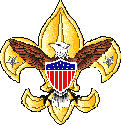| MERIT BADGES |
|
|
|
|
| Note: Eagle Required are in Italics |
"A"
American
Business
American Culture
American Heritage
American Labor
Animal Science
Archaeology
Archery
Architecture
Art
Astronomy
Athletics
Atomic Energy
Auto Mechanics
Aviation
"B"
Backpacking
Basketry
Bird Study
Bugling
"C"
Camping
Canoeing
Chemistry
Cinematography
Citizenship
Community*
Citizenship Nation*
Citizenship World*
Climbing
Coin Collecting
Collections
Communications*
Computers
Cooking
Crime Prevention
Cycling*
"D"
Dentistry
Disability Awareness
Dog Care
Drafting
"E"
Electricity
Electronics
Emergency
Preparedness**
Energy
Engineering
Entrepreneurship
Environmental
Science*
"F"
Family Life*
Farm Mechanics
Fingerprinting
Fire Safety
First Aid*
Fish & Wildlife Mgmt.
Fishing
Fly Fishing
Forestry
"G"
Gardening
Genealogy
Geology
Golf
Graphic Arts
"H"
Hiking
Home Repairs
Horsemanship
"I"
Indian Lore
Insect Studies
"J"
Journalism
"K"
"L"
Landscape Architecture
Law
Leatherwork
Lifesaving**
"M"
Mammal Study
Medicine
Metalwork
Model Design & Building
Motorboating
Music
"N"
Nature
"O"
Oceanography
Orienteering
"P"
Painting
Personal Fitness**
Personal Management*
Pets
Photography
Pioneering
Plant Science
Plumbing
Pottery
Public Health
Public Speaking
Pulp and Paper
"Q"
"R"
Radio
Railroading
Reading
Reptile & Amphibian Study
Rifle Shooting
Rowing
"S"
Safety
Salesmanship
Scholarship
Sculpture
Shotgun Shooting
Skating
Skiing
Small Boat Sailing
Soil & Water
Conservation
Space Exploration
Sports**
Stamp Collecting
Surveying
Swimming**
"T"
Textile
Theatre
Traffic Safety
Truck Transportation
"U"
"V"
Veterinary Medicine
"W"
Water Skiing
Weather
Whitewater
Wilderness Survival
Wood Carving
Woodwork
"X"
"Y"
"Z"
 Fire Safety Fire SafetyRequirements 1995 |
- Explain the chemistry and physics of fire. Name the parts of the fire tetrahedron. Explain why vapors are important to the burning process. Name the products of combustion. Give an example of how fire grows and what happens.
- Name the most frequent causes of fire in the home and give examples of ways it can be prevented.
- List the actions that cause seasonal fires and explain how these fires can be prevented.
- List common circumstances that cause holiday-related fires and explain how these fires can be prevented.
- List the most frequent causes of burn injuries.
- Conduct a home safety survey with the help of an adult, then do the following:
- Draw a home fire escape plan, create a home fire drill schedule, and conduct a home fire drill.
- Test a smoke alarm and demonstrate regular maintenance of a smoke alarm. (Note: Establish a pattern. For example, change smoke alarm batteries at least once a year -- on the same birthday or holiday each year, or when you set your clocks forward for daylight saving time in the spring, or back in the fall for return to standard time.)
- Explain what to do when you smell gas and when you smell smoke.
- Explain how you could call in a fire alarm.
- Explain what fire safety equipment may be found in public buildings.
- Explain who should use fire extinguishers and when they can be used.
- Do the following:
- Demonstrate lighting a match safely.
- Demonstrate the safe way to start a charcoal fire.
- Demonstrate how to extinguish a grease pan fire.
- Demonstrate the safe way to melt wax.
- Explain the difference between combustible and noncombustible liquids and between combustible and noncombustible fabrics.
- Do the following:
- Demonstrate the safe way to fuel a lawnmower.
- Demonstrate the safety factors, such as proper ventillation, for auxiliary heating devices and the proper way to fuel such devices.
- Demonstrate the technique of stop, drop, roll, and cool. Explain how burn injuries can be prevented.
- Do the following:
- Explain the cost of outdoor and wildland fires and how to prevent them.
- Demonstrate setting up and putting out a cooking fire.
- Demonstrate using a camp-stove and lantern.
- Explain how to set up a campsite safe from a fire.
- Visit a fire station. Identify the types of fire trucks. Find out about the fire prevention activities in your community.
|
||||||
Last Update May 15, 2023

.jpg)
